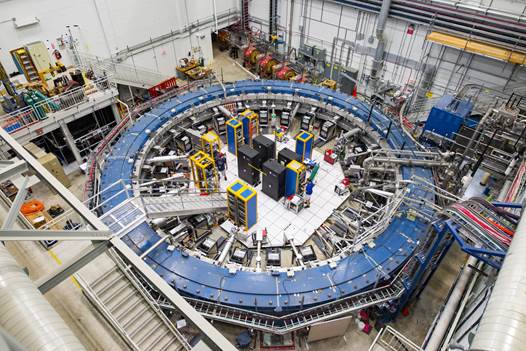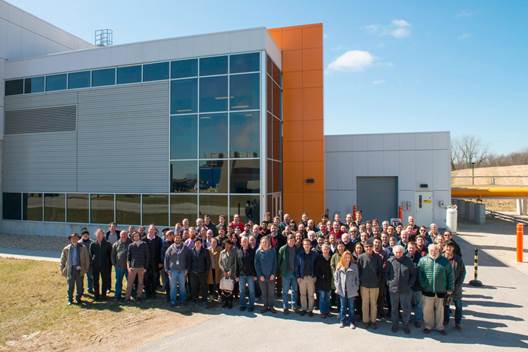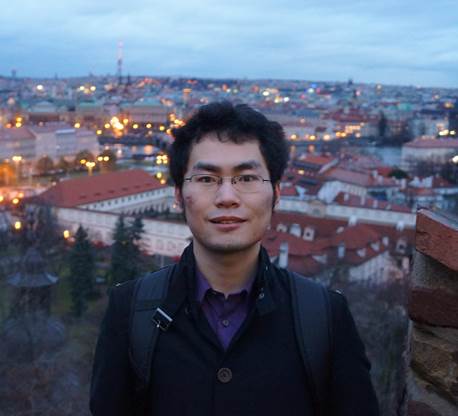The first results from the Muon g-2 experiment at the U.S. Department of Energy’s Fermi National Accelerator Laboratory were unveiled on April 7. It shows fundamental particles called muons behave in a way that is not predicted by scientists’ best theory, the Standard Model of particle physics and they could be interacting with yet undiscovered particles or forces. Assistant Professor Li Dikai from College of Engineering Physics, Shenzhen Technology University (SZTU), is one of the collaborators of the experiment and a co-author of the new paper. The result was published in the following four scientific articles: Physical Review Letters (PRL), Physical Review A (PRA), Physical Review Accelerators and Beams (PRAB) and Physical Review D (PRD). The full text of the article can be found under: https://journals.aps.org/prl/abstract/10.1103/PhysRevLett.126.141801.

The centerpiece of the experiment is a 50-foot-diameter superconducting magnetic storage ring. [Photo/Fermilab]
Muons are elementary particles comparable to electrons and act as if they have a tiny internal magnet. As the muons circulate in the Muon g-2 magnet, they also interact with a quantum foam of subatomic particles popping in and out of existence. Interactions with these short-lived particles affect the value of the g-factor (the rate that the muon precesses in an external magnetic field), causing the muons’ precession to speed up or slow down very slightly. The Standard Model predicts this so-called anomalous magnetic moment extremely precisely. However, if the quantum foam contains unknown forces or particles not accounted for by the Standard Model, the muon g-factor would be tweaked further.

Muon g-2 Collaboration group photo in 2017 [Photo/Fermilab]
The predecessor experiment at DOE’s Brookhaven National Laboratory, which concluded in 2001, offered hints that the muon’s behavior disagreed with the Standard Model. Researchers have reused the main component from the Brookhaven experiment and taken advantage of Fermilab’s particle accelerator to produce the most intense beam of muons in the United States. From 2013, researchers had assembled the experiment at Fermilab and thoroughly tested the entire system in the following four years. In its first year of operation, in 2018, the Fermilab experiment collected more data than all prior muon g-factor experiments combined. With more than 200 scientists from 35 institutions in 7 countries, the Muon g-2 Collaboration has now finished analyzing the motion of more than 8 billion muons from that first run. Data analysis on the second and third runs of the experiment is underway, the data fetch on the fourth run is ongoing, and a fifth run is planned. Combining the results from all five runs will give scientists an even more precise measurement of the muon’s wobble, revealing with greater certainty whether new physics is hiding within the quantum foam.
With the most accurate result to date, the new measurement from the Muon g-2 experiment at Fermilab strongly agrees with the value found at Brookhaven and diverges from the current theory. This landmark result, made with unprecedented precision, confirms a discrepancy that has been gnawing at researchers for decades.

Assistant Professor Li Dikai [Photo/College of Engineering Physics]
Assistant Professor Li Dikai became a collaborator at Fermilab’s Muon g-2 experiment in 2016 and joined SZTU in June last year. Apart from the research on the experiment, he also works on building the Physics Laboratory of Electron Accelerator with researchers from Center for Advanced Material Diagnostic Technology at SZTU.
*Part of this article was first published on the official website of Fermi National Accelerator Laboratory, April 7, as selected and edited by International Cooperation & Student Affairs Office, SZTU.
Drafted by Daisy(姚琦)/ International Cooperation & Student Affairs Office
Edited by International Cooperation & Student Affairs Office
